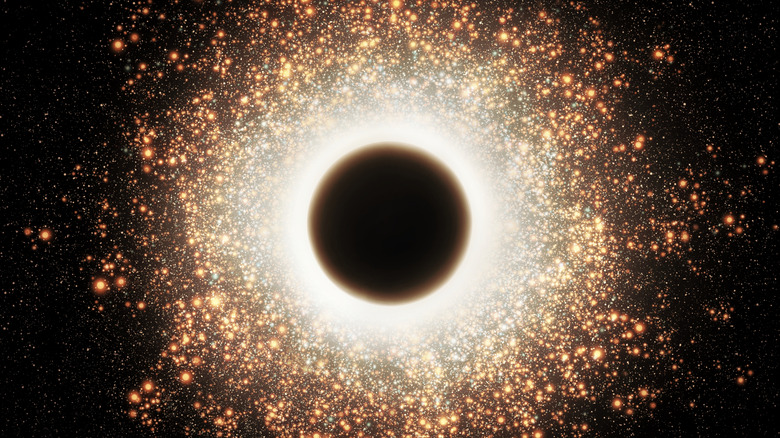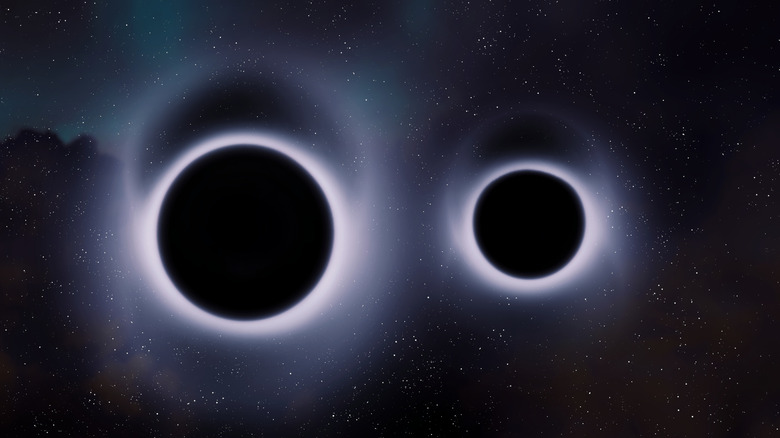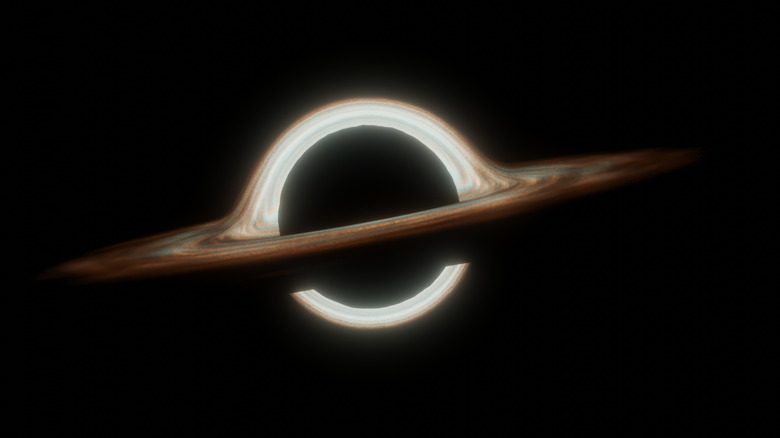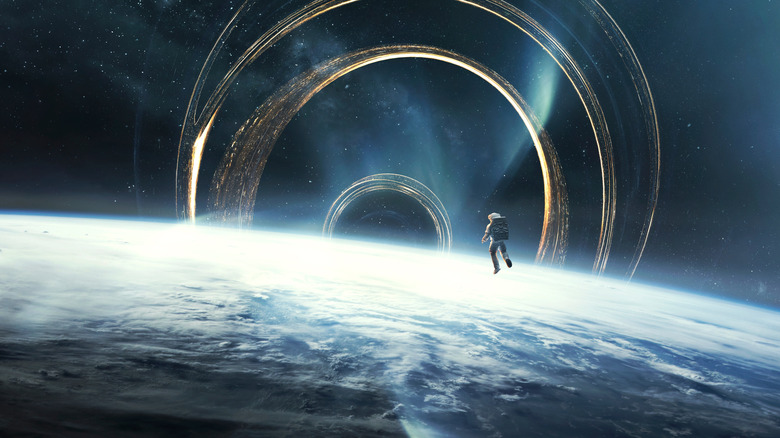The Disturbing Fate Of Anyone Who Falls Into A Black Hole
Black holes are one of the most fascinating mysteries in the cosmos, and the more we discover about these cosmic objects the more mysterious they become. Named by theoretical physicist John Wheeler, black holes are not actually holes at all, but rather areas of space where matter is so densely packed that everything held within the black hole collapses to a single point, called a singularity. Because these black holes neither emit nor reflect light they are essentially invisible in and of themselves, and only observable based on the effect they have on their surroundings.
Of course, observing these impressive cosmic objects, or rather the environment surrounding them, can only be done at a great distance. Even the nearest known black hole, Gaia BH1, is still roughly 1,500 light-years from Earth, though nobody would want to get too close to it even if they could. The gravity at the edge of a black hole is so strong that nothing, not even light itself, can escape once it is sucked inside. This is because the velocity required to break through the surface of a black hole — known as the event horizon — exceeds the speed of light. Since nothing can travel faster than the speed of light, nothing can escape a black hole — though scientists have theorized about ways in which information could pass from inside the black hole and out through the event horizon.
Despite what would surely be a strange and terrifying experience, however, many have surely wondered what it would be like to get sucked into one of these cosmic monoliths.
The types of black holes
There is no shortage of myths surrounding black holes, from the idea that they are actually wormholes to the prediction that the universe will one day be subsumed by them. But scientists actually have a fairly solid understanding of the composition of a black hole, such that we have a rough idea of what would happen were someone to actually get pulled across the event horizon.
The first thing to note is that this experience would actually vary quite drastically depending on the type of black hole in question, of which there are three main categories here: Stellar-mass black holes are the smallest, intermediate-mass black holes are somewhere in the middle, and supermassive black holes are gargantuan beasts that occupy the extreme end of the scale.
While it might sound like a truly profound experience to cross the mysterious threshold that is the event horizon of a black hole, when it comes to supermassive black holes, you wouldn't actually realize you'd made the transition. This has to do with the fact that the event horizon itself is relatively small compared to the overall size of the black hole, and there are no strong tidal forces — a term that refers to the difference in gravity between two points. In a supermassive black hole, the tidal forces at the event horizon are weak enough that you would simply slip over the lip of the event horizon without feeling much of anything. Of course, once inside you would be trapped, but at least you'd make it inside in one piece.
Things get a lot more terrifying, however, when it comes to crossing the event horizon of a stellar-mass black hole.
Stellar-mass black holes and spaghettification
While passing across the event horizon of a supermassive black hole might not be all that harmful to an individual's health, things are a lot different when it comes to stellar-mass black holes. This is because the tidal forces at the event horizon of these smaller cosmic objects are extremely strong, which means that as an individual approaches the threshold, they would undergo a process called "spaghettification."
This is a real term used to describe the way in which objects become stretched out as they approach the event horizon of a stellar-mass black hole. It occurs due to the difference in the gravitational force between each end of an object, which in human terms would be the difference in gravitational force between our head and our feet. As an object falls into a black hole, the closest end of that object to the event horizon will experience a stronger gravitational pull than the end furthest from the event horizon. The difference in gravitational pull between these two points begins to stretch the object out as it gets nearer the black hole, resulting in the object becoming elongated like a piece of spaghetti, before ultimately being torn apart by the increasing difference in gravitational pull. So if falling feetfirst, a human's feet would be stretched away from their head like taffy.
Because black holes are so incredibly dense, the spaghettification effect in the case of stellar-mass black holes is incredibly intense. To put it simply, were you to fall towards one, you wouldn't even make it past the event horizon before being spaghettified.
The same fate awaits anyone who ventures into a black hole
If you were to make it across the event horizon, what would a black hole be like inside? Well, it's important to note that there is no way to know for sure, as some experts believe that piercing the event horizon is a complete impossibility and that general relativity — one of the major breakthroughs of Albert Einstein — breaks down completely around a black hole. But theoretically, in the case of supermassive black holes, while the transition across the event horizon might be relatively uneventful, the experience of actually being inside would be incomprehensibly weird.
Aside from being trapped in the black hole itself, the laws of physics as we know them would be completely upended. As physicist and gravitational wave astronomer at the University of Oregon, Ben Farr, told Newsweek, were someone to theoretically make it beyond the event horizon of a black hole, there would likely be a "substantial warping of images from gravitational lensing," which refers to the way light is affected by the way black holes curve spacetime itself. You would likely be able to see outside of the black hole, but the light hitting your eye would be warped. What's more, while you would be able to look out at space, anybody looking at the black hole itself would not be able to see you.
Things would only get worse as you get closer to the singularity. The closer an individual moves to the center of the black hole, the more likely it is they become spaghettified, and according to Farr, this would likely happen within a few minutes of crossing the horizon. So, whether it's a stellar-mass black hole or the supermassive variety, spaghettification awaits anybody who ventures inside either way.



